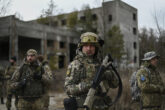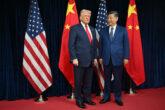May 03, 2021
China and Russia’s Dangerous Convergence
On March 23, Chinese Foreign Minister Wang Yi and his Russian counterpart, Sergey Lavrov, sat down for an auspiciously timed meeting. The high-level talks came just a day after an unusually heated public exchange between senior U.S. and Chinese officials in Anchorage, Alaska, and in sharp contrast, the Chinese and Russian foreign ministers struck an amicable tone. Together, they rejected Western criticism of their human rights records and issued a joint statement offering an alternative vision for global governance. The U.S.-led international order, Lavrov said, “does not represent the will of the international community.”
The meeting was noteworthy for more than its rhetoric, however. Within days of it, Russia began amassing troops along Ukraine’s border—the largest number since Moscow’s annexation of Crimea in 2014. Simultaneously, China began conducting highly publicized amphibious assault exercises and air incursions into Taiwan’s so-called air defense identification zone at the highest frequency in nearly 25 years. These military moves have reignited concerns in Washington about the potential depth of Chinese-Russian coordination.
Any effort to address either Russia’s or China’s destabilizing behavior must now account for the two countries’ deepening partnership.
For the United States, confronting these decidedly different adversaries will be a tall order, and the two countries will inevitably divide Washington’s attention, capabilities, and resources. The events of the last several weeks make clear that the administration of President Joe Biden will have difficulty managing Chinese behavior without addressing Moscow’s support for Beijing and that Washington must now calculate how its response to one adversary will shape the calculus of the other.
The problems the two countries pose to Washington are distinct, but the convergence of their interests and the complementarity of their capabilities—military and otherwise—make their combined challenge to U.S. power greater than the sum of its parts. China, in particular, is using its relationship with Russia to fill gaps in its military capabilities, accelerate its technological innovation, and complement its efforts to undermine U.S. global leadership. Any effort to address either Russia’s or China’s destabilizing behavior must now account for the two countries’ deepening partnership.
Read the full article from Foreign Affairs.
More from CNAS
-
Transatlantic Security / Middle East Security
The Russia-Iran Partnership: A Geopolitical Balancing ActIt has been almost a year since Russia and Iran signed their comprehensive strategic partnership. That deal established a 20-year partnership between the two countries coverin...
By Andrea Kendall-Taylor & Jim Townsend
-
Defense / Transatlantic Security
Ukraine’s Catch-22 MomentThis article was originally published in the Financial Times. In Joseph Heller’s wartime classic, Catch-22, the protagonist Yossarian seeks out the US army surgeon Doc Daneeka...
By Franz-Stefan Gady
-
Transatlantic Security / Middle East Security / Energy, Economics & Security
Sanctions Aren’t Enough to Shut Down the Moscow-Tehran Black Market for WarThe geographic scope and extent of Iranian-Russian cooperation highlights the failure of traditional sanctions to prevent Moscow and Tehran from seeking key components like ch...
By Delaney Soliday
-
Indo-Pacific Security / Energy, Economics & Security
How to Win the Economic War with ChinaTrump's approach to China has run aground, giving Beijing unprecedented advantage in the economic conflict....
By Edward Fishman & Julian Gewirtz




